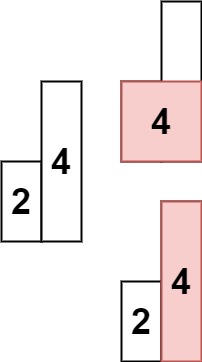LeetCode-in-All
84. Largest Rectangle in Histogram
Hard
Given an array of integers heights representing the histogram’s bar height where the width of each bar is 1, return the area of the largest rectangle in the histogram.
Example 1:

Input: heights = [2,1,5,6,2,3]
Output: 10
Explanation: The above is a histogram where width of each bar is 1. The largest rectangle is shown in the red area, which has an area = 10 units.
Example 2:

Input: heights = [2,4]
Output: 4
Constraints:
1 <= heights.length <= 1050 <= heights[i] <= 104
To solve this task using Python with a Solution class, you can follow these steps:
- Define a class named
Solution. - Inside the class, define a method named
largestRectangleAreathat takesheightsas an input parameter. - Implement an algorithm to find the area of the largest rectangle in the histogram.
- Use a stack-based approach to efficiently find the largest rectangle.
- Initialize a stack to store the indices of bars in non-decreasing order of heights.
- Iterate through each bar in the histogram:
- If the stack is empty or the current bar’s height is greater than or equal to the height of the bar at the top of the stack, push the index of the current bar onto the stack.
- Otherwise, repeatedly pop indices from the stack and calculate the area of the rectangle with the popped bar as the smallest bar. Update the maximum area if necessary.
- After iterating through all bars, if the stack is not empty, repeat step 6 with remaining bars in the stack.
- Return the maximum area found.
Here’s the implementation:
class Solution:
def largestRectangleArea(self, heights):
max_area = 0
stack = []
heights.append(0) # Append 0 to the end to handle the case when all bars are ascending
for i in range(len(heights)):
while stack and heights[i] < heights[stack[-1]]:
height = heights[stack.pop()]
width = i if not stack else i - stack[-1] - 1
max_area = max(max_area, height * width)
stack.append(i)
return max_area
# Example usage:
solution = Solution()
print(solution.largestRectangleArea([2,1,5,6,2,3])) # Output: 10
print(solution.largestRectangleArea([2,4])) # Output: 4
This solution efficiently finds the largest rectangle area in the histogram using a stack-based approach. It iterates through the histogram only once, resulting in a time complexity of O(n), where n is the number of bars in the histogram.
Solution
from typing import List
class Solution:
def largestRectangleArea(self, heights: List[int]) -> int:
lefts = [0]
best = 0
heights.append(0)
for i,h in enumerate(heights):
if h > heights[lefts[-1]]:
lefts.append(i)
elif h == heights[lefts[-1]]:
pass
elif h < heights[lefts[-1]]:
while lefts and h < heights[lefts[-1]]:
left = lefts.pop()
hh = heights[left]
ww = i - left
if hh * ww > best:
best = hh * ww
lefts.append(left)
heights[left] = h
return best

